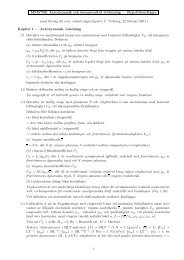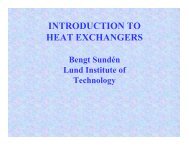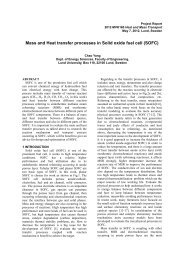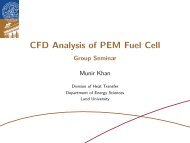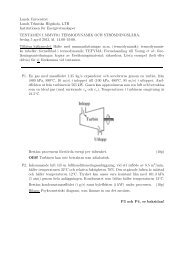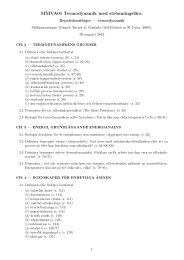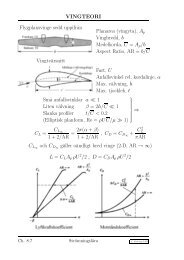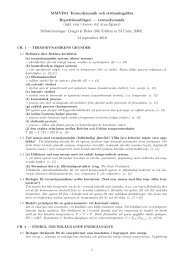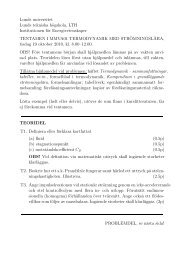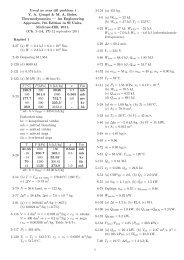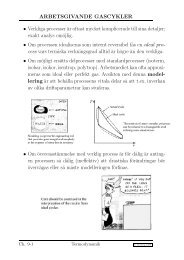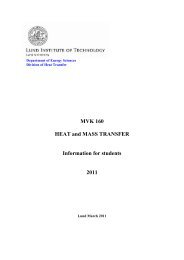Condensation Heat Transfer Overview of Four Lectures Contents
Condensation Heat Transfer Overview of Four Lectures Contents
Condensation Heat Transfer Overview of Four Lectures Contents
You also want an ePaper? Increase the reach of your titles
YUMPU automatically turns print PDFs into web optimized ePapers that Google loves.
<strong>Condensation</strong> <strong>Heat</strong> <strong>Transfer</strong><br />
Dr Vishwas Wadekar<br />
Technology Director, HTFS Research<br />
Aspen Technology<br />
Filmwise<br />
<strong>Condensation</strong><br />
<strong>Overview</strong> <strong>of</strong> <strong>Four</strong> <strong>Lectures</strong><br />
• Lecture 1<br />
– <strong>Condensation</strong> - I<br />
• Lecture 2<br />
– <strong>Condensation</strong> - II<br />
– Enhancement <strong>of</strong> heat<br />
transfer<br />
• Lecture 3<br />
– Pool boiling heat<br />
transfer<br />
– Flow patterns<br />
– Flow boiling heat<br />
transfer<br />
• Lecture 4<br />
– Enhancement <strong>of</strong> boiling<br />
<strong>Contents</strong><br />
Modes <strong>of</strong> condensation<br />
Dropwise/filmwise condensation<br />
Direct/indirect/homogeneous<br />
condensation<br />
Filmwise condensation on<br />
Flat plate<br />
Outside/inside a tube<br />
Other complex effects<br />
Industrial equipment<br />
Dropwise<br />
<strong>Condensation</strong><br />
Filmwise
Filmwise <strong>Condensation</strong><br />
Condensed liquid forms a continuous liquid<br />
film on the heat transfer surface<br />
Examples <strong>of</strong> heat transfer surface can be<br />
Flat plate (as in the diagram)<br />
Outside/inside a tube<br />
Plate <strong>of</strong> a plate heat exchanger<br />
<strong>Heat</strong> transfer coefficient is lower (than<br />
dropwise mode) but predictable and stable<br />
Almost all industrial equipment is designed for<br />
this mode <strong>of</strong> condensation<br />
Dropwise <strong>Condensation</strong><br />
Condensed liquid forms droplets on the<br />
heat transfer surface due to poor<br />
wettability<br />
Very high heat transfer coeff. (50-500<br />
kW/m 2 K)! However, it can degrade to<br />
filmwise values over time<br />
This mode is promoted by<br />
Surface coating (e.g. with PTFE)<br />
Additives in vapour stream<br />
Still an area <strong>of</strong> ongoing research to<br />
make it work in industrial practice<br />
Homogeneous <strong>Condensation</strong><br />
Small droplets forming as fog<br />
Increase in pressure can lead to fog formation<br />
Droplets <strong>of</strong>ten too small to separate<br />
Fog and cloud formation are due to<br />
homogeneous nucleation<br />
Undesirable in industrial practice<br />
Loss through venting system<br />
Possible source <strong>of</strong> pollution
Direct Contact <strong>Condensation</strong><br />
Subcooled liquid is brought<br />
in contact with vapour<br />
Latent heat raises the<br />
temperature <strong>of</strong> subcooled<br />
liquid<br />
Efficient form <strong>of</strong> heat<br />
exchange<br />
Sea water desalination<br />
Power plants<br />
Emergency core cooling in<br />
nuclear reactors<br />
Vapour<br />
Liquid Spray<br />
Vapour<br />
<strong>Condensation</strong><br />
In the remaining lecture we now focus<br />
on indirect contact filmwise<br />
condensation<br />
Filmwise<br />
<strong>Condensation</strong><br />
Resistances to <strong>Heat</strong> <strong>Transfer</strong><br />
Pure vapour<br />
Pure vapour<br />
+<br />
non-condensable<br />
T i = T sat<br />
T g<br />
T i<br />
vapour<br />
vapour+gas<br />
coolant<br />
liquid<br />
film<br />
coolant<br />
liquid<br />
film<br />
p v,b<br />
p v,i
General Approach to<br />
<strong>Condensation</strong><br />
Filmwise condensation is considered<br />
Various geometries are covered<br />
Flat plate (vertical and inclined)<br />
Outside/inside a single tube<br />
Outside multiple tubes (tube bundle)<br />
Gravity controlled situations studied in<br />
detail<br />
Further complicating factors such as<br />
inundation and vapour shear effects are<br />
then examined briefly<br />
General Approach to<br />
<strong>Condensation</strong><br />
<strong>Condensation</strong> on Flat Plate<br />
Nusselt analysed this case in<br />
1916<br />
Analysis is considered in detail<br />
because -<br />
Milestone in condensation work<br />
Simplest geometry<br />
Forms the basis <strong>of</strong> other<br />
geometries
Nusselt Analysis -<br />
Assumptions<br />
Laminar condensate film<br />
Gravitational and viscous forces only<br />
<strong>Heat</strong> transfer by conduction through the<br />
film<br />
Thermodynamic equilibrium at the<br />
interface<br />
Uniform -<br />
Physical properties<br />
Wall temperature<br />
Nusselt Analysis - I<br />
From film analysis<br />
V&<br />
=<br />
( ρ − ρ )<br />
l<br />
g<br />
3η<br />
gδ<br />
3 W<br />
T w<br />
δ<br />
T sat<br />
We define the mass flow rate per<br />
unit width as<br />
V&<br />
ρ<br />
Γ =<br />
W<br />
l<br />
ρ<br />
=<br />
l<br />
( ρ − ρ )<br />
l<br />
3η<br />
g<br />
gδ<br />
3<br />
Nusselt Analysis - II<br />
Liquid film flowrate, G, increases with distance,<br />
x. If G c is condensation mass flux then from<br />
mass balance G c = dΓ/ dx<br />
T sat<br />
As<br />
ρ<br />
Γ =<br />
l<br />
( ρ − ρ )<br />
l<br />
3η<br />
g<br />
gδ<br />
3<br />
T w<br />
dx<br />
dΓ<br />
ρl<br />
G<br />
c=<br />
=<br />
dx<br />
( ρ − ρ )<br />
l<br />
3η<br />
g<br />
g<br />
3δ<br />
2<br />
dδ<br />
dx
Nusselt Analysis - III<br />
<strong>Condensation</strong> mass flux G c is related to<br />
heat flux, q& c , by q&<br />
= ∆h v<br />
G c<br />
(∆h v = latent heat <strong>of</strong> vaporisation)<br />
T w<br />
δ<br />
T sat<br />
<strong>Heat</strong> transfer through the film is by<br />
conduction. Therefore the heat transfer<br />
coefficient will be (λ l / δ)<br />
λ<br />
l<br />
q&<br />
=<br />
δ<br />
( Tsat<br />
− Tw<br />
) = ∆hvG<br />
c<br />
Combining….<br />
<strong>Condensation</strong> mass flux G c and<br />
heat transfer equation<br />
G<br />
λ<br />
l<br />
δ<br />
c<br />
( Tsat<br />
− Tw<br />
) = ∆hvG<br />
c<br />
ρ<br />
=<br />
l<br />
( ρ − ρ )<br />
l<br />
η<br />
g<br />
g<br />
δ<br />
2<br />
dδ<br />
dx<br />
<strong>Condensation</strong> mass flux G c and<br />
film flow equation<br />
δ 3<br />
ηλ<br />
dδ<br />
=<br />
ρ<br />
l<br />
( T − T )<br />
dx<br />
l sat w<br />
( ρl<br />
− ρ<br />
g<br />
) g∆hv<br />
On integrating…..<br />
x<br />
δ<br />
Local Coefficient<br />
….On integrating<br />
δ<br />
4<br />
4ηλ<br />
=<br />
ρ<br />
l<br />
( T − T )<br />
x<br />
l sat w<br />
( ρl<br />
− ρ<br />
g<br />
) g∆hv<br />
Local heat transfer coefficient<br />
( ρ − ρ )<br />
1/ 4<br />
3<br />
λ ⎡λ<br />
ρ g∆h<br />
4 ( ) ⎥ ⎥ ⎤<br />
l l l l g v<br />
α = = ⎢<br />
δ ⎢⎣<br />
η Tsat<br />
− Tw<br />
x ⎦
Average Coefficient<br />
On integrating<br />
⎡λ<br />
ρ<br />
( ρ − ρ )<br />
3<br />
α 1<br />
= ∫ L<br />
l l l g<br />
αdx<br />
= 0.943 ⎢<br />
L 0<br />
η( T − T ) L<br />
sat w<br />
⎢⎣<br />
g∆h<br />
v<br />
⎤<br />
⎥<br />
⎥⎦<br />
1/ 4<br />
x = L<br />
δ<br />
OR<br />
αZ<br />
Nu = = 1.47 Re<br />
λ<br />
⎡<br />
Z = ⎢<br />
⎢⎣<br />
ρ<br />
l<br />
l<br />
η<br />
2<br />
−1/<br />
3<br />
⎤<br />
4Γ<br />
;Re =<br />
⎥<br />
( ρ − ρ ) g η<br />
l<br />
g<br />
⎥⎦<br />
1/ 3<br />
where<br />
Nusselt Analysis -<br />
Assumptions<br />
Laminar condensate film<br />
Gravitational and viscous forces only<br />
<strong>Heat</strong> transfer by conduction through<br />
the film<br />
Thermodynamic equilibrium at the<br />
interface<br />
Uniform -<br />
Physical properties<br />
Wall temperature<br />
Verification <strong>of</strong> Nusselt<br />
Analysis<br />
Earlier attempts to experimental<br />
verification were not successful because <strong>of</strong><br />
Presence <strong>of</strong> non-condensible gases<br />
Presence <strong>of</strong> dropwise condensation<br />
Forced convective effects (vapour shear)<br />
Rippling, splashing and turbulence <strong>of</strong> the<br />
film<br />
Recent data under “Nusselt conditions”<br />
validates the simple Nusselt theory
Extension <strong>of</strong> Nusselt Analysis<br />
Condensate subcooling - Bromley<br />
(1952); Rohsenov (1956)<br />
Condensate inertia forces and convection<br />
- Sparrow and Gregg (1959a, 1959b)<br />
Shear stress at the interface - Koh et al<br />
(1961); Chen (1961)<br />
Uniform wall heat flux - Fuji et al (1972)<br />
General Approach to<br />
<strong>Condensation</strong><br />
W = πDi<br />
Laminar <strong>Condensation</strong> in<br />
Vert. Tubes<br />
3<br />
⎡λ<br />
lρ<br />
α = 0.924 ⎢<br />
⎢⎣<br />
l<br />
( ρ − ρ )<br />
l<br />
ηΓ<br />
l<br />
g<br />
g ⎤<br />
⎥<br />
⎥⎦<br />
1/ 3<br />
W = πDo
<strong>Condensation</strong> on Horizontal<br />
Tubes<br />
Gravity controlled<br />
condensation on a single<br />
horizontal tube is examined<br />
The analysis is then extended<br />
to industrial situation <strong>of</strong><br />
multiple tubes in a bundle<br />
considering inundation effects<br />
Single Horizontal Tube<br />
3<br />
⎡λ<br />
lρl<br />
α = 0.728 ⎢<br />
⎢⎣<br />
η<br />
( ρ − ρ )<br />
l<br />
( T − T )<br />
sat<br />
g<br />
w<br />
g∆h<br />
D<br />
o<br />
v<br />
⎤<br />
⎥<br />
⎥⎦<br />
1/ 4<br />
In alternate form<br />
3<br />
⎡λ<br />
lρ<br />
α = 1.523 ⎢<br />
⎢⎣<br />
l<br />
3<br />
( ρ ) ⎤<br />
1/<br />
l<br />
− ρ<br />
g<br />
1/ 3<br />
η<br />
2<br />
⎥<br />
⎥⎦<br />
Re<br />
−<br />
l<br />
Inundation Effects<br />
Indundation - Condensate from<br />
upper tubes falls on the lower<br />
tubes<br />
This increases the condensate<br />
thickness, decreasing the<br />
condensation coefficient<br />
α<br />
= α<br />
− n<br />
N<br />
N 1/<br />
1<br />
n= 4 - Nusselt theory<br />
n= 6 - Kern from experience
<strong>Condensation</strong> in Horizontal<br />
Tube<br />
Vapour<br />
Film draining<br />
under gravity<br />
Liquid pool<br />
Gravity controlled<br />
case<br />
Vapour shear<br />
controlled case<br />
<strong>Condensation</strong> in Horizontal Tube<br />
φ<br />
Coefficient for top region where film is<br />
drained:-<br />
α<br />
Top<br />
3<br />
⎡λ<br />
lρl<br />
= β⎢<br />
⎢⎣<br />
η<br />
( ρ − ρ )<br />
l<br />
( T − T )<br />
sat<br />
g<br />
w<br />
g∆h<br />
D<br />
i<br />
1/ 4<br />
β depends<br />
v<br />
on the<br />
angle φ<br />
⎤<br />
⎥<br />
⎥⎦<br />
Average coefficient for the top and bottom region is:-<br />
( ρ − ρ )<br />
1/ 4<br />
3<br />
⎡λ<br />
⎤<br />
lρl<br />
l g<br />
g∆hv<br />
φβ<br />
α<br />
Tube<br />
= Ψ⎢<br />
⎥ where,<br />
Ψ =<br />
⎢⎣<br />
η( Tsat<br />
− Tw<br />
) Di<br />
⎥⎦<br />
π<br />
Jaster and Kosky (1976) obtained Ψ from void fraction<br />
Vapour Shear Effects<br />
Vapour shear effects arise from forced<br />
convective motion <strong>of</strong> the vapour<br />
Vapour shear thins the liquid film,<br />
thereby increasing the coefficient<br />
Onset <strong>of</strong> laminar to turbulent<br />
transition occurs at lower Reynolds<br />
number<br />
Shekriladze and Gomelauri (1966)<br />
developed equations for vertical vapour<br />
down flow
Industrial Equipment<br />
Pure vapour<br />
+<br />
non-condensable<br />
T g<br />
• Drainage <strong>of</strong> condensate is<br />
important. <strong>Condensation</strong> is<br />
almost always carried out in<br />
downflow manner<br />
coolant<br />
T i<br />
vapour+gas<br />
p liquid<br />
v,b<br />
film<br />
p v,i<br />
• Provision <strong>of</strong> a vent for noncondensable<br />
gas at proper<br />
location is <strong>of</strong> paramount<br />
importance.<br />
Enhanced <strong>Condensation</strong> Surfaces<br />
Special surfaces enhance<br />
condensation by<br />
Localised thinning <strong>of</strong> the<br />
condensate film using surface<br />
tension effects<br />
(‘Gegorrig surfaces’)<br />
Easy condensate drainage<br />
Enhanced condensation tubes<br />
are commercially available<br />
More <strong>of</strong>ten these are used as<br />
“double enhancement” devices<br />
Vapour<br />
Cooling wall<br />
Condensate<br />
For a Convex Surface…<br />
σ<br />
pl<br />
= psat<br />
+<br />
r<br />
• Differentiating with<br />
respect to distance<br />
along a fin<br />
( 1 r)<br />
dp d<br />
= σ<br />
/<br />
dz dz<br />
• For a concave surface<br />
( 1 r)<br />
dp d<br />
= −σ<br />
/<br />
dz dz



